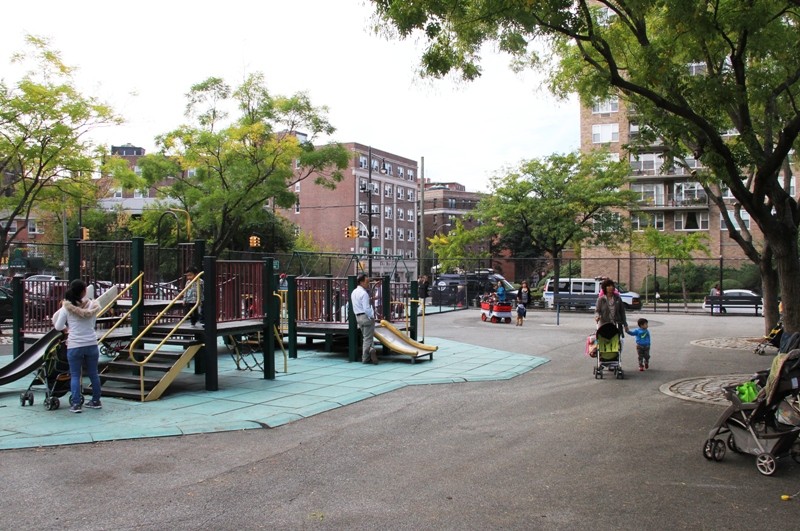
Grassmere-Playground
Place Category: Parks and Playgrounds
This playground takes its name from the adjacent Grassmere Terrace housing complex. Playgrounds have a long and storied history in New York City. From 1865 to 1895, New York City’s population more than doubled. As thousands of new immigrants moved into already overcrowded tenement districts, the streets teemed with children, many of whom worked long hours in factories. With the enactment of the first child labor laws at the turn of the 20th century, leading reformers in New York City lobbied for the creation of a new kind of small park for children — the playground.
The earliest playgrounds, called “sand gardens,” appeared in the 1880s on the grounds of settlement houses. Furnished with innovative play equipment like see-saws, and staffed by trained recreation specialists, the playground was designed to be a “healthful influence upon morals and conduct.” As Teddy Roosevelt (1858-1919) 26th U.S. President, who had been President of the Playground Association of America at that time, wrote: “If we would have our citizens contented and law-abiding, we must not sow the seeds of discontent in childhood by denying children their birthright of play.” For these reformers, recreation was not an end in itself: it was directly linked to the preservation of social morality.
Groups such as the New York Society for Parks and Playgrounds formed to raise awareness of the importance of play for children’s health. The Society organized parades of mothers and babies, planned public meetings to demonstrate the use of the see-saw, and opened its own playground on Second Avenue and 91st Street. In 1903, the first municipally run playground in the United States, Seward Park, opened on the Lower East Side.
In the Depression era 1930s, federal aid through the Works Progress Administration (WPA) enabled the City to expand and improve its play spaces. Under the stewardship of Parks Commisioner Robert Moses, new playgrounds were constructed at an astonishing rate throughout the decade. Moses was able to harness the massive manpower of the Parks Department, whose ranks had swollen to more than 80,000 workers due primarily to the influx of federal money to stem unemployment through large public works projects. Moses increased the number of playgrounds in New York City from 119 when he became Commissioner in 1934 to 777 in 1960, the end of the Moses era at the Parks Department.
These playgrounds, designed for use by a wide age group, were most often large asphalted areas adorned with sandboxes, see-saws, metallic jungle-gyms and monkey bars, swing sets and slides. Although Moses’s playground construction program greatly benefited many overcrowded city neighborhoods, some believed that he neglected poorer neighborhoods. Moses also battled with local residents who felt that park space should be used only for conservation of scarce open land, not for recreation.
The concern for safety in playgrounds remains an important issue today. Many rules and guidelines govern the types of play areas allowed. Equipment now sits upon safety surfacing. New forms of play equipment have been introduced.
This playground is located at the intersection of Grassmere Terrace, Brookhaven Avenue, and Briar Place in Rockaway, Queens. Parks acquired the land in 1955 in conjunction with the Board of Education. The adjacent school, P.S. 215, is named for Lucretia Mott (1793-1880). Mott advocated woman’s rights and fought to end slavery. She organized the first women’s rights convention in 1848 and gave many speeches denouncing slavery.
Commissioner Stern named the property Grassmere Playground in 1985. Mayor Giuliani provided $150,338 for a reconstruction of this playground in 1998. New play equipment with safety surfacing, handball courts, asphalt baseball diamond and benches were installed, and new sidewalks, paths, and paving surfacing were laid. Additional equipment includes a basketball hoop, swings, and a flagpole with a yardarm.
- Grassmere Playground
Queens
New York
11691
United States No Records Found
Sorry, no records were found. Please adjust your search criteria and try again.
Google Map Not Loaded
Sorry, unable to load Google Maps API.
-

